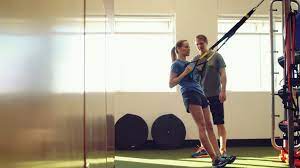Learn how to develop your own TRX workouts by building TRX complexes. Want to find the perfect workout combinations for your fitness level? Take our quick assessment quiz to get personalized guidance on creating effective TRX circuits. These are sequences of TRX movements in a continuous circuit at very high intensity in a timed or reps/sets scheme with little or no rest between movements for a set number of rounds or time. A growing body of scientific literature including this recent study from the University of Denmark, Copenhagen supports the efficacy of high intensity training as compared to steady state aerobic training (what has traditionally been called "the fat burning zone"). The simplicity and versatility of the TRX allows users to create complexes perfectly tailored to their specific needs. Here are some guidelines for developing and implementing effective TRX complexes.
TAKE OUR TRAINING QUIZ
Step One: Balance of Basic Movements
If you're shooting for a complex geared towards whole body training and general conditioning, select a minimum of four exercises that cover all four basic human movements:
- Pushing
- Pulling
- Squatting
- Core
If you're new to TRX Suspension Training or working with a trainee who is new to TRX Suspension Training, this is a great starting point for designing a basic complex. A sample complex might look like this:
- Pushing: TRX Chest Press
- Pulling: TRX Low Row
- Squatting: TRX Squat
- Core: TRX Crunch
That's a solid first step for designing your own complexes. If you're more fit, working with more advanced trainees or seek a greater challenge, then Step Two is for you.
Step Two: Multi-planar Balance
The next step is to work from this basic premise to select exercises that also reflect a roughly even balance between the three fundamental planes of movement:
- Frontal Plane
- Sagittal Plane
- Transverse Plane
*If you haven't read it yet, hustle over to Fraser Quelch's excellent article on planar training for a thorough look at the importance of this concept.
Step Three: More Multi-planar Bang for Your Buck
But keep in mind that many TRX movements task the body in more than one plane of movement. This means that the TRX allows you to select unique Suspension Training exercises for inclusion in the complexes you design that task the body in more than one plane of motion within a single movement.
For example, the TRX Power Pull turns the traditionally sagittal plane dominant motion of rowing into a movement that combines all three planes of movement—sagittal, transverse and frontal—by virtue of including rotational elements in addition to the linear, back-and-forth motion of a traditional two handed row (like the TRX Low Row).
Single leg and single arm TRX movements task the body in the transverse plane by virtue of requiring the body to generate anti-rotational force in the transverse plane in order to stay stable. Try a TRX Single Arm Row or TRX Single Arm Chest Press to experience this transverse plane anti-rotational challenge. When unilaterally performing the TRX Chest Press and TRX Low Row, part of the difficulty of these traditionally sagittal plane movements (pushing and pressing in a linear plane) becomes resisting the rotation that comes with the decreased stability of doing them with a single arm or leg.
You can find exercises in each of the four major categories of movement (push, pull, squat, core) to include in your complex that touch on all three planes of motion to achieve multi-planar balance.
Examples of squatting movements that task the body in all three planes of motion include the TRX Crossing Balance Lunge, TRX Lunge (with Rotation) and TRX Squat (Single Arm).
Examples of core movements that task the body in all three planes of motion include the TRX Side Plank (with Tap), the TRX Oblique Crunch and the TRX Scorpion.
Here's a four exercise TRX complex utilizing exercises with internal multi-planar balance:
1. TRX Chest Press (Single Arm)
2. TRX Power Pull
3. TRX Crossing Balance Lunge (with Hop)
4. TRX Oblique Crunch
Complexes can certainly include more than four exercises. But four is a solid starting point for basic complex design. You can also take a cue from the work of Coach Dos, Alwyn Cosgrove and the protocols found in the TRX Boot Camp: Ropes and Straps DVD and integrate other modalities or metabolic conditioning between TRX movements for an even more intense challenge.
A multi-modal complex might look like this:
- TRX Chest Press
- Bear Crawl
- TRX Mountain Climber
- Crab Crawl
- TRX Lunge (with Rotation)
- Overhead Med Ball Swing to Slam
- TRX Burpees
Step Four: Execution
Now that you've selected your exercises, decide what scheme you will use to execute your complex—timed rounds, sets and reps or ascending or descending ladders (10-1, 1-10, etc.). However you set up your complex, be mindful that even when shooting for a maximum number of rounds, reps or sets within a given time frame, never sacrifice form. The key to effective training is to always use good form to reinforce correct movement patterns.
Now have at it!
Don't have a TRX Suspension Trainer yet? Get one here and get to work.
Andrew Vontz is a journalist and trainer who writes for TRX. He programs functional training for endurance sports and life.



